eISSN: 2576-4462


Research Article Volume 7 Issue 4
1Department of Life Sciences, Faculty of Science and Technology, The University of the West Indies, Mona Campus, Kingston 7, Jamaica
2Department of Microbiology, Faculty of Medical Sciences, The University of the West Indies, Mona Campus, Kingston 7, Jamaica
Correspondence: Machel A. Emanuel, Department of Life Sciences, Faculty of Science and Technology, The University of the West Indies, Mona Campus, Kingston 7, Jamaica
Received: November 10, 2023 | Published: November 27, 2023
Citation: Goodridge JJ, Ozongwu CJ, Emanuel MA, et al. Terra vera technology usage for suppression of coffee leaf rust Hemileia vastatrix in Brandon Hill, Jamaica. Horticult Int J. 2023;7(4):139-144. DOI: 10.15406/hij.2023.07.00287
In Jamaica the incidence of Coffee Leaf Rust (CLR) continues to contribute to the reduction in coffee production annually. Terra Vera Technology (TV) offers a safer alternative to Highly Hazardous Pesticides (HHP) due to its formulation of a non-toxic, all-natural solution. This investigation aimed to assess the efficacy of TV on coffee plants displaying symptoms of coffee leaf rust (CLR). The experimental research plot was established in the Blue Mountain coffee growing region of Brandon Hill, St Andrew, where plants were assessed for the incidence of CLR. Disease presenting plants were allocated with one of four experimental conditions; a 2:1 or 3:1 solution of reverse osmosis (RO) water to TV, RO water alone or no-application at all. Each experimental condition included plants with a range of disease severities as determined using a disease severity chart. The evidence presented may suggest some level of suppression of CLR from the use of TV on infected coffee plants. The relative change in disease severity was reduced on the coffee plants that were applied with TV versus the controls assessed over a nine-week period. For all the coffee plants that were applied with TV, the decrease in levels of CLR observed was consistent for both concentrations. The 3:1 TV was less effective than the 2:1 TV, from week 5 of TV applications and assessments; a significant (< 0.05) difference between the TV 3:1 and TV 2:1 was observed. The results generated are indicative of the 2:1 TV concentration as being a potential antifungal agent for the treatment and suppression of CLR disease.
Keywords: coffee leaf rust, terra vera technology, coffee, jamaica
The Jamaican coffee industry produces an Arabica (Figure 1) varietal which has a longstanding reputation as being among the best coffee in the world. Jamaica is especially known for its Jamaica Blue Mountain (JBM) coffee brand which is cherished as a mild, smooth coffee with an earthy, deep aroma with hints of chocolate. The niche that Jamaican coffee has held in the global market has made coffee production a valuable segment of the local agricultural sector, contributing USD 16 million per annum. The JBM coffee is grown at elevations ranging from a low of 550 meters up to 1600 meters, with the best beans growing between 1100 and 1600 meters. At these elevations, the higher quality Coffea arabica thrives; the berries mature more slowly and produce a drink with more delicate flavours than those grown at lower elevations. According to the Jamaica Agricultural Commodities Regulatory Authority (JACRA), the Blue Mountains in eastern Jamaica is home to nearly 80% of the island's 5000 coffee farmers.1 The JBM coffee brand has had a stronghold within the Japanese market for the last three decades, due to a direct trade deal between the two countries.1,2 Today, Japan purchases roughly 85% of all certified JBM Coffee.2
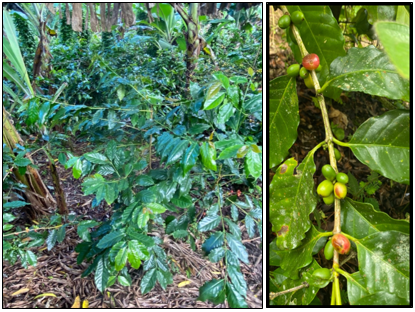
Figure 1 C. arabica L. A) characteristic shrub/tree. B) Fruit-bearing plagiotropic branch.
(Photographs taken at the Brandon Hill coffee farm, C. arabica L)
Coffee Leaf Rust (CLR) is regarded as the most devasting and widespread disease of coffee throughout the world; its infestation has devastated many coffee industries globally. Once the disease is established in an area, it is difficult to eliminate, despite multiple strategies that may be implemented by coffee farmers.3 Therefore, farmers must learn to cope with it and implement practices to prevent and manage the disease. CLR is caused by a fungal pathogen from the genus Hemileia (Figure 2), a member of the phylum Basidiomycota, of the class Pucciniomycetes. More specifically, it is part of the largest group of plant pathogens known as “rust fungi” or Pucciniales.4 The rust fungi are obligate biotrophs which extract their nutrients only from the living plant tissues and therefore cannot grow apart from their plant host.5 The effects of CLR (Figure 3) are not only significant within the production cycle but also in the subsequent two or three years following. Although CLR is not generally fatal to coffee plants, it may affect the growth, fruiting ability and vegetative development, which can generate polyetic epidemics over successive seasons. Factors including climate, altitude, shade, soil fertility and canopy architecture, can influence disease severity.6
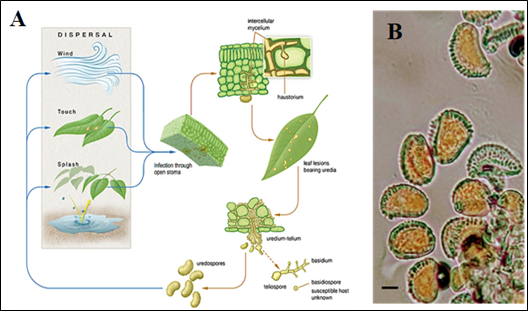
Figure 2 Hemileia vastatrix.
(A) Mode of transmission & lifecycle (Perfecto, 2020).
B) Characteristic uredospores sampled from a coffee plant in Brandon Hill, Jamaica (bar = 10 mm) provided by author.
Temperature and humidity are very important factors for the successful proliferation of the disease, whilst latitude and altitude determine the temperature, as well as, cloud cover, and seasonal/microclimate conditions. Solar radiation levels can indirectly affect the infection process of H. vastatrix by altering the leaf temperature and air temperature around the leaf.7 Tree areas fully exposed to the morning sun which have a shorter duration of leaf wetness, show lower rates of infection of CLR. The microclimate of the canopy’s middle to lower sections have higher humidity levels, thereby presenting with a greater severity of disease observed.8 Equally, increased shade levels allow a moist atmosphere to persist, prolonging the duration of leaf wetness, thereby creating a favourable environmental condition for sporulation.7
The use of patented technologies compliant with EPA regulations such as TV, offers producers a safe, effective and sustainable approach to reducing levels of contaminants, while preserving the integrity of the horticultural commodity. The TV technology mimics nature’s autoimmune systems by converting organic, inert compounds into an antimicrobial solution, found to be effective at inactivating many common plant pathogens. The solution is designed to remediate and prevent pathogenic outbreaks that can incur significant crop losses. Previous unpublished studies on Cannabis with use of TV technology have demonstrated the reduction of microbial activity postharvest, to acceptable CFU rates for samples that used the TV technology compared to the samples that were not exposed to TV. This investigation aims to assess the potential usage of TV technology, in suppressing and reducing the incidence of CLR on coffee production of JBM coffee located in Brandon Hill, St Andrew, Jamaica.
Study site
The district of Brandon Hill is located in the parish of West Rural St. Andrew, in the eastern part of the island of Jamaica. The district is hilly, which makes it particularly suitable for the cultivation of the highly valued JBM quality coffee variety. The district is one of the largest contributors to coffee production within the parish of St. Andrew and accounts for the largest number of registered active coffee farmers in any of the parish’s districts. A total of 174 coffee farmers are based in the Brandon Hill district whereas the entire St. Andrew area is host to around 2,450 active farmers. Coffee production in the parish largely depends on smallholders, whereby 34 % of coffee farmers work less than 1 acre of land, and 44 % between 1 and 4 acres for a total of 787 acres.9 Coffee farms are mainly intercropped with bananas and plantains, to provide necessary shade for coffee plants as well as additional produce. The coffee crop cycle lasts for one year. Pesticide application is carried out mainly outside of the coffee picking season, which runs from August to March. Pesticides are usually applied by male workers using a knapsack sprayer.10
Establishment of research plot
JACRA is a statutory body which falls under the Ministry of Agriculture and Fisheries. The regulatory authority is tasked with the mandate of providing the regulatory functions of the cocoa, coffee and coconut industries in Jamaica. A preliminary survey was conducted with JACRA officials to determine a suitable study site with incidence of CLR and no recent usage of fungicides, for establishment of a research plot in the coffee production region of St Andrew, Jamaica. A coffee farm in the Brandon Hill, St Andrew coffee growing district was selected based on the confirmation of CLR disease and the ability to acquire confirmation of no recent application of fungicide over the last three cropping cycles for the farm in question and neighbouring coffee farms. Consent was granted by JACRA and the owner of the smallholder coffee farm, permitting the research activity to be carried out.
Experimental design
The entire six acre smallholder coffee farm located in Brandon Hill coffee growing district was scouted for, to estimate the severity of CLR present for determination of incident levels using a standard area diagram (Figure 4). A total of sixty (60) coffee plants were selected based on established severity levels ranging from 1 (being lowest) and 6 (being highest). Four (4) experimental conditions were established with fifteen (15) coffee plants per experimental condition, for weekly assessment. The four (4) experimental conditions were as follows:
■ 15 coffee plants with no treatment
■ 15 coffee plants treated with Reverse Osmosis water (RO water) only
■ 15 coffee plants treated with a concentration of 2:1 TV solution (two parts RO water to one part Terra Vera technology)
■ 15 coffee plants treated with a concentration of 3:1 TV solution (three parts RO water to one part Terra Vera technology)
All 60 coffee plants selected as part of the experimental design, were monitored and assessed weekly for a total period of nine (9) weeks between July and August 2022.
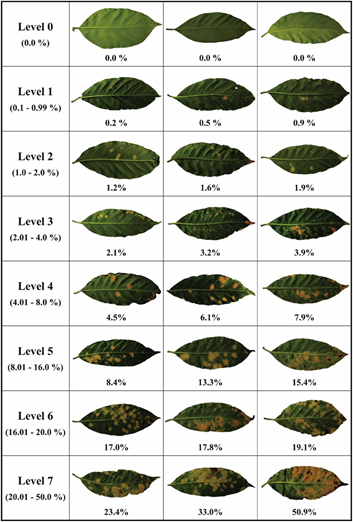
Figure 4 Standard area diagram constructed with color photographs to aid in estimating the severity of coffee leaf rust (Hemileia vastatrix) in conilon coffee (Coffea canephora). The numbers represent the percentage of diseased leaf area containing urediniospores of the pathogen, disregarding the light-yellow halo around the lesions. (Belan et al., 2020)
Preparation of TV stock solution
A full bag of the precursor powder was added to a 1 gallon bucket of RO water. The contents were mixed thoroughly to ensure the precursor powder was completely dissolved. Three (3) buckets were placed under the Terra Vera electrolysis unit located at the Life Science department at the University of the West Indies, Mona Campus Jamaica, with the respective hoses for the precursor concentrate, RO water and the collection of stock solution. The power switch was turned on and the Terra Vera electrolysis unit was allowed to calibrate to optimum conditions before the collection of the Terra Vera stock solution. Once the sufficient volume of this stock solution was collected, the electrolysis unit was switched off and the Terra Vera stock solution was stored in a cool, dark area before being transported to the Brandon Hill coffee growing district to be utilised as per the experimental design.
Application of TV and RO water
A concentrated stock solution of Terra Vera technology was prepared weekly to ensure the solution of Terra Vera chemistry was activated. The fifteen (15) coffee plants for each treatment were conducted in a randomized block design (each experimental condition having a range of severity levels from 1-6 (Figure 4) across the 6-acre coffee plot with the aim of creating clusters of plants with different micro climates for each experimental condition assessed in the study. Two separate hydraulic backpack sprayers were procured for the applications described above: one for the application of TV (2:1 and 3:1 concentrations) and one for the application of the RO water. The same backpack sprayer operator applied the TV technology and the RO water weekly. A total of eight applications were conducted on Tuesdays between the hours of 8 am and 11 am on a weekly basis. During the applications the backpack sprayer operator ensured the leaves of the plants of both the abaxial and adaxial surfaces, were sprayed with either the RO water or the appropriate TV concentration (2:1 or 3:1).
Laboratory identification of Hemileia vastatrix
CLR disease-presenting leaf samples were collected and transported in sterile specimen bags, to the Mycology Laboratory of the University of the West Indies Department of Microbiology, Mona Campus, Jamaica. Using the Sellotape mount technique, spores were prepared for direct microscopy by placing one drop of Lactophenol Cotton Blue (LCB) stain, onto a glass slide for direct visualization of fungal elements. A piece of tape was pressed down onto the spore mass on the leaf and transferred to the LCB by carefully pressing onto the surface of the glass slide. The sample preparation was placed directly onto a light microscope stage and read under x40 (4000) magnification for the visualization of the spores. Processing of samples was conducted within a Class II Biological Safety Cabinet, to minimize potential environmental contamination and exposure risks associated with the sample.
Data collection
Each week the prevalence and severity of CLR was assessed and estimated using a standard area diagram with colour photographs (Figure 4) to aid in estimating the severity of disease.11 A marked region of each tree consisting of three (3) or more branches, was used to estimate and document disease severity within each experimental condition and the most appropriate/representative severity rating was applied to the tree. The severity of disease for each plant within each treatment condition was estimated and the average (mean, mode, median) and relative changes in severity levels were calculated. The efficacy of TV technology in reducing the severity of CLR was determined based on severity levels of CLR assessed throughout the nine-weeks observational period. Five (5) coffee plants per experimental treatment were selected for weekly photographs of the abaxial and adaxial surfaces of leaves, taken throughout the experimental protocol.
Statistical analysis
A statistical analysis was conducted using the Kruskal Wallis, Friedmann’s and Mann-Whitney tests, where the treatments were used as fixed effects in the completely randomized plot layout. The software program used for the analysis was SPSS. In all cases, significant differences were defined as those with P<0.05.
CLR Hemileia vastatrix
Macroscopic and microscopic examination of diseased leaves revealed the presence of uredospores characteristic of H. vastatrix, thus confirming species identification (Figure 2).
Disease severity
The average initial (prior to treatment applications) severity levels of CLR established for the fifteen (15) coffee plants undergoing each experimental condition were 3.3 for the 2:1 TV, 3.6 for the 3:1 TV, 3.3 for the RO water and 2.9 for the no application. The changes in severity levels of CLR were compared between each experimental condition, according to the relative changes in levels of severity over the eight-week application period (Figure 5). The largest reduction in CLR severity was observed in the experimental condition where the 2:1 TV technology was applied, followed by the 3:1 TV condition, the RO water and no application, respectively. For the experimental condition where no application was applied a steady increase in CLR disease severity levels was observed for the first five weeks.
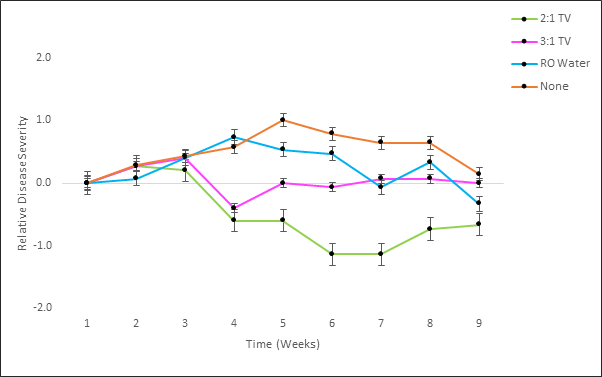
Figure 5 Average relative change in CLR disease severity levels for all four experimental conditions, over time.
Effectiveness potency.
2:1 TV
The largest reduction in severity of CLR during the nine weeks of observation was seen with the 2:1 TV treatment (Figure 5, Figure 6). For example, in two of the fifteen coffee plants undergoing the 2:1 experimental condition, a decline in CLR disease severity from level 4 (4-8%) to level 1 (0.1-0.99%) was observed after 3 weeks of weekly applications. In three coffee plants that were assessed to have initial CLR severity levels of 5, 6 and 6 respectively, final severity levels of 5, 4 and 5 were observed. Two coffee trees that were initially observed to have relatively high CLR severity levels of 5 and 6, had after the nineth week, remained constant in severity levels or increase only slightly. Of the fifteen coffee plants assessed for the 2:1 TV treatment, 66.7% (n=10) of the plants were observed to have lower CLR disease severity levels, 20% (n=3) displayed higher final severity levels and 13.5% (n=2) had the same final severity levels as those which were observed at the beginning of the nine-week study. In 60% of the coffee plants, a steady decline in CLR disease severity levels were observed during weeks 4, 5 and 6.
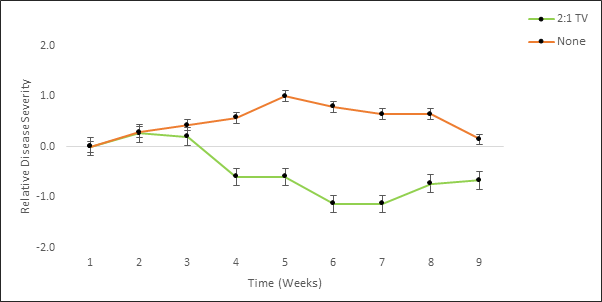
Figure 6 Comparison of average relative change in CLR disease severity levels for 2:1 TV treatment and no-application study conditions.
3:1 TV
The 3:1 category saw the second lowest relative increase in disease level, with a relatively steady disease level maintained, from weeks 5 to 9 (Figure 5). Notably, disease levels for the 3:1 category, remained to be less than that of the no-application control from weeks 3 onwards (Figure 7). Of the fifteen plants receiving the 3:1 TV technology over the eight-week assessment period; 33% (n=5) had lower final CLR severity levels, 46.5% (n=7) of coffee plants displayed higher final CLR severity levels and 20% (n=3) displayed the same final CLR severity levels compared to the starting severity levels measured. The two TV treatment concentrations (2:1 and 3:1) assessed, the greatest reduction in disease severity levels in a single plant was observed in the 3:1 treatment category. For this particular coffee plant that was treated with 3:1 TV, the CLR severity levels moved from a level 6 to a level 3 within a two-week period. Conversely, the 3:1 TV category also included a coffee plant that displayed the highest increase in CLR disease severity from a level 4 to a level 7 upon final assessment.
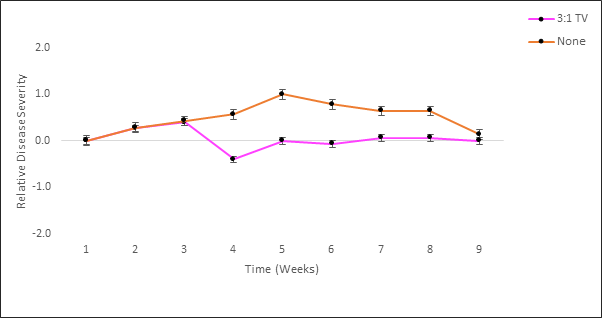
Figure 7 Comparison of average relative change in CLR disease severity levels for 3:1 TV treatment and no-application study conditions.
Control conditions; RO water (negative control) and no- application (blank control)
The trends observed for CLR disease severity levels were similar for the two control conditions of RO water and no-application (Figure 8). Both experimental conditions displayed the largest relative increases in levels of CLR disease, during the first 4 to 5 weeks of the overall assessment period. The CLR severity level for the RO water peaked at week 4, while the experimental condition for no application peaked at week 5. As a result of severe defoliation, a coffee tree assessed for no application had to be excluded from the weekly assessments after week 3.
Coffee is grown island-wide in Jamaica, with approximately 80% of the island’s coffee cultivated in the Blue Mountain. The island is famous for the Typica a Coffea arabica variety which is known for its exceptional quality and taste. Typica, relative to other varieties, thrives with medium amounts of agricultural inputs, tends to have a lower yield potential and is highly susceptible to CLR. Japan in particular have come to associate the Blue Mountain coffee brand with Typica’s distinct flavour profile. Jamaica’s reputation for producing high quality coffee bean is due to a combination of factors such as the environment, how the specific cultivar responds to the climate and how the soil type provides the bioavailability of nutrients for producing the berries.
CLR was first observed in Jamaica in 198612 but was largely confined to lower elevations. This trend changed in 2012-2013 when CLR affected Jamaican coffee farms across the full elevation range of the BM region. It has been estimated that around 25-30% of coffee producing areas in the BM are affected by CLR, with farmers’ incomes having fallen by approximately 25%.13 Many farmers reported to have been severely affected by the presence and incidence of CLR being widespread, with a high level of tree mortality. CLR is known to thrive in humid and wet climates, however the severity and prevalence can also be affected by farm practices. Addressing CLR at the farm level has largely entailed a combination of the implementation of improved farming techniques and management aimed to minimize rust impact.
The Coffee Industry Board reported that between 2014 and 2015, only 62% of farmers did not apply fungicides, despite losses incurred by the presence of CLR.14 Chemical control of CLR is the obvious choice in the absence of a resistant genotype and other effective disease management strategies. Jamaica’s response to CLR has been so far centered on curtailing the disease through farm level practices such as fungicide applications. Metallic copper fungicides have proven to be most effective, particularly the copper oxychloride formulations.15 Although dithiocarbamate protectant fungicides have been shown to be useful, their application is limited due largely to being unstable at increased temperatures and humidity as well as their short residual life.16,17 Fungicide efficacy depends both on timing of application and complete coverage of the toxicant. Important factors to note are spray volume, droplet size and coverage.
The findings of this study may suggest some level of suppression of CLR from the use of TV technology on infected coffee plants in Brandon Hill, Jamaica. The relative change in disease severity was significantly reduced in the coffee plants to which TV technology vs the controls, over the 9-week period. For all the coffee plants treated with TV technology, the decrease in levels of CLR observed up to week 4, was consistent for both concentrations. However, the 3:1 TV was less effective than the 2:1 TV, from week 5 of applications and assessments, with a significant (< 0.05) difference between the two TV test concentrations. At week 6 and 7 the 2:1 TV applications observed the largest difference in the average relative severity levels, while for the same period the 3:1TV CLR severity levels remained constant. With the high level of rainfall experienced from week 4 into the investigations may have impacted the TV technology in reducing sporicidal activity observed in the first 3 weeks of the investigations. The sporicidal activity of the 2:1 TV technology, may be attributed to the specified concentration used , effectively reducing the average relative severity levels of CLR observed. The more dilute 3:1 TV concentration did not have the same impact in reducing the average relative severity levels, particularly in week 6 and 9 there was no significant difference between the 3:1 TV and the two controls observed. The RO water condition (negative control) absent of any active chemical, may have provided more favorable conditions for the spread and colonization of CLR spores, with the steady increase in the average relative severity levels observed in the first 3-weekly assessments. The greatest single increase in the average relative severity level was observed for the no treatment in week 5. From week 5 to week 8 the coffee plants observed for no treatment had the highest average relative severity levels for all the plants observed. Based on the patterns of average relative CLR severity levels observed, climatic factors may also have affected the sporulation cycle of CLR, with Jamaica’s rainy season beginning in June, in line with the commencement of the study. On numerous occasions, the intensity, frequency and duration of the rainfall, was prolonged and torrential in nature, which may have diluted or removed the TV applications, thus reducing the potential activity of the fungicide at reducing CLR. The farmers in the area also commented that this type of rainfall was usually associated with the seasonal rainfall patterns. The farmers also reported extensive rainfall during the days between assessing and sampling for severity levels of CLR.
The two cultivars of coffee observed on the small holder coffee farm were the Typica (the most dominant cultivar observed) and Geisha varieties. The Typica cultivar was observed to be more susceptible to CLR, showing heavy symptoms of disease and defoliation. The extensive defoliation observed throughout the study made it difficult to assess the same area for severity levels of CLR, with leaves assessed on previous weeks often being absent in the weeks that followed. Therefore, recommendations including a longer observational period used over a cropping cycle, the use of multiple locations (with different elevations and climatic variations) and the assessment of various cultivars, would provide a more comprehensive study for assessing the efficacy of TV technology as a fungicide in suppressing the incidence and spread of CLR in Jamaica BM coffee.
During the interview conducted the farmer commented on the lack of protective gear required compared to that for synthetic chemicals used for suppressing CLR in Jamaica. He elaborated on how unwell the other fungicides had made him feel immediately after using them, as compared to when applying the TV technology. When asked if he would he recommend TV technology to other farmers in the Brandon Hill area,, he stated that “Yes” he had “observed it to be more environmentally friendly and safer” for him (to use) and that he “could see it working”. He also stated that he believed that “even better results would have been seen, had the experiment not been conducted during the rainy season where the results may not have been so promising.” Finally he commented on the affordability and shelf life of the TV technology being other factors making TV a more viable option for farmers in the region.
Terra Vera patented based technology mimics nature’s auto immune systems by converting organic, inert compounds into an antimicrobial solution effective at inactivating many common plant pathogens of bacterial and fungal origins. In conclusion, the data generated over a nine-week period in the BM coffee growing region, demonstrated significant difference between experimental conditions assessed. The infected coffee trees with CLR that were applied with TV technology showed a reduction in the average severity levels observed. The largest reduction was observed for the more concentrated (TV 2:1) solution applied to the infected CLR plants. A similar reduction in average severity levels was also observed for TV 3:1, however this reduction was not sustained in comparison to the TV 2:1 solution.
The use of TV technology as an anti-fungal agent against CLR may prove as an effective method for controlling CLR in coffee production. However, the ability to detect CLR early, the timing of application, the concentration of the TV technology solution, climatic factors, types of cultivars assessed and the sanitation methods practiced by the farm workers, may all increase the efficacy of TV technology. (Appendix 1)
The authors would like to thank Jamaica Agricultural Commodities Regulatory Authority JACRA for their assistance and approval in carrying out this investigation.
Authors declare no conflict of interest exist.

©2023 Goodridge, et al. This is an open access article distributed under the terms of the, which permits unrestricted use, distribution, and build upon your work non-commercially.